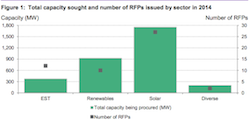 Ecotech Institute is hosting a “Competitive Landscape of the Green Revolution” seminar on Tuesday, March 24, 2015 from 12-12:30 pm MDT. The event will be held at Ecotech Institute in Aurora, Colo. and will also be simulcast live, for those who cannot attend in person. The free forum, which will be led by Craig Mataczynski, the CEO of Gradient Resources, will offer students and guests, interested in a green energy career, an employer’s perspective on what it takes to succeed.
Ecotech Institute is hosting a “Competitive Landscape of the Green Revolution” seminar on Tuesday, March 24, 2015 from 12-12:30 pm MDT. The event will be held at Ecotech Institute in Aurora, Colo. and will also be simulcast live, for those who cannot attend in person. The free forum, which will be led by Craig Mataczynski, the CEO of Gradient Resources, will offer students and guests, interested in a green energy career, an employer’s perspective on what it takes to succeed.- Solar Power, Inc. has announced that Yue Dong has joined SPI as Chief Technology Officer (CTO). Mr. Dong joins SPI from lvmama.com, one of China’s largest B2C online travel agencies, where he served as CTO. Dong will focus on overseeing the technical operations and ongoing optimization of SPI’s online investment platform, Solarbao.com, and providing technology support for SPI’s solar power plant operations and maintenance system. He will also lead SPI’s initiatives in big data analysis for power efficiency optimization management.
- Ceres, Inc. and Brazilian energy company Raízen S.A., have announced that they have signed a multi-year collaboration agreement to develop and produce sweet sorghum on an industrial scale. Sweet sorghum can be grown to complement existing feedstock supplies and extend the operating season of Brazilian sugarcane-to-ethanol mills. Under the collaboration, the companies will each contribute in-kind services and resources and share in the revenue from the ethanol produced from Ceres’ sweet sorghum above certain levels. This season, Raízen has planted Ceres’ sweet sorghum evaluation in a single location and plans to expand to multiple mills in the seasons to come.
- SolarCity and DIRECTV have announced a first-of-its-kind program. Under the new service relationship, DIRECTV technicians visiting customers’ homes will be able to offer those homeowners the opportunity to use solar electricity from SolarCity, making it possible for them to pay less than their current utility rates. To celebrate the new relationship, qualified SolarCity customers who sign up to go solar between March 11 and March 18, 2015 are eligible for a special $400 rebate to be paid upon installation.
NASCAR Tops 7 Million Miles with American Ethanol
 NASCAR began running Sunoco Green E15 in its three top national series back in 2011 and on Saturday at the Phoenix International Raceway the league surpassed seven million miles of racing on the fuel with American Ethanol.
NASCAR began running Sunoco Green E15 in its three top national series back in 2011 and on Saturday at the Phoenix International Raceway the league surpassed seven million miles of racing on the fuel with American Ethanol.
“NASCAR has shown under the most demanding competition that E15 is safe, reliable and it works,” said Dr. Michael Lynch, Vice President, NASCAR Green Innovation and STEM Platforms. “NASCAR fans are 80 percent more likely than non-fans to support the use of ethanol blends in their own car on the street, because they understand that NASCAR and our diligent race teams did our homework from the start with thousands of miles and hours of testing.”
Richard Childress, Chairman and CEO of Richard Childress Racing, says the move to Sunoco Green E15 has actually boosted the performance of the race cars – lowering emissions and increasing horsepower. “Since this change took place, we have seen increased horsepower from a higher-octane ethanol fuel blend and decreased emissions. In our own internal tests at RCR, we used ethanol blends up to E30 and found no issues with that fuel, either,” said Childress.
NASCAR made the fuel change in conjunction with their NASCAR Green® Platform, the largest and most comprehensive recycling, tree planting and renewable energy programs in sports.
New Oregon Gov Ends Sunset on Clean Fuels Law
 The new governor in Orgeon has signed a measure that ends the sunset on the state’s clean fuels law, something which is seen as a boost to biodiesel and ethanol on the West Coast. Governor Kate Brown cited global warming concerns and neighboring areas’ own rules on alternative energy for signing the Clean Fuels legislation:
The new governor in Orgeon has signed a measure that ends the sunset on the state’s clean fuels law, something which is seen as a boost to biodiesel and ethanol on the West Coast. Governor Kate Brown cited global warming concerns and neighboring areas’ own rules on alternative energy for signing the Clean Fuels legislation:
“I strongly support SB 324’s goal to reduce greenhouse gas emissions. It is difficult to deny that we are seeing the effects of a warming planet. This year, 85 percent of our state is experiencing drought, with 33 percent experiencing extreme drought. This directly impacts 1.5 million Oregonians, hitting our rural communities the hardest. With California, Washington, and British Columbia moving forward with their own clean fuels programs, which will shape the West Coast market, it is imperative not only that Oregon does its part to reduce greenhouse gas emissions but also that we build a program that meets the needs of Oregonians.
“I appreciate the years of work by countless Oregonians who helped develop this law, and I applaud the Oregon Legislature for its thorough examination of these issues. The work begins now to ensure this program is well implemented and well managed.”
The measure ending the sunset of the Clean Fuels program passed by a very narrow margin in the state legislature. It also comes on the heels of the Oregon Environmental Quality Commission approving earlier this year phase two of the Oregon Clean Fuels Program. The new rules, developed by the Oregon Department of Environmental Quality, went into effect February 1.
Wind Industry Reacts to Wind Vision
The Wind Vision report released yesterday by the U.S. Department of Energy (DOE) is spurring reaction across the wind industry. The report describes a new scenario for wind to reach 10 percent by 2020, 20 percent by 2030, and 35 percent by 2050, and provides a road map for government and industry to get there. Wind industry executives are going on record saying they can and will deliver the goals set forth in the plan.
“We can do this and save you money by doing it,” said Tom Kiernan, CEO of the American Wind Energy Association (AWEA). “This definitive report provides the wind industry with aggressive targets for the growth of wind energy  in America, and we stand ready to meet them. It starts with getting common-sense policies in place, so we can double U.S. wind energy in the next five years.”
in America, and we stand ready to meet them. It starts with getting common-sense policies in place, so we can double U.S. wind energy in the next five years.”
In response to the report, AWEA along with the Wind Energy Foundation will set forth more than 50 industry executives and professionals to serve as ambassadors to educate Americans and elected officials about wind power benefits. In addition, over 400,000 supporters of wind energy have signed a petition calling on state and federal lawmakers to support the needed policies.
“This report documents how wind energy already provides major economic and environmental benefits to America, including protecting consumers against energy price spikes, and making deep cuts in pollution and water use,” added John Kostyack, executive director of the Wind Energy Foundation. “As wind becomes one of the country’s top sources of electricity, Wind Vision promises even bigger benefits for decades to come.”
Wind Vision envisions how consumers will immediately benefit from more stably priced energy. With more wind energy, electricity prices would be 20 percent less sensitive to fluctuations in the price of fossil fuels, the report finds. Consumers would see $280 billion in economy-wide savings from reduced natural gas prices alone. Investing in more U.S. wind turbines would pay further economic dividends, such as by creating more jobs and causing further reductions in air pollution. The up-front investment to achieve these benefits will cost electric consumers only pennies a month in the early years, the report shows.Read More
Bobby Likis to Spotlight Ethanol Exports
 Syndicated car-talk program “Bobby Likis Car Clinic” will feature a discussion on global demand for U.S. ethanol and its co-products on this week’s globalcast which airs live on Saturday morning March 14.
Syndicated car-talk program “Bobby Likis Car Clinic” will feature a discussion on global demand for U.S. ethanol and its co-products on this week’s globalcast which airs live on Saturday morning March 14.
 Judd Hulting of Patriot Renewable Fuels will talk with Bobby about the operations, products and statistics of Patriot’s ten-year old, ethanol plant located near the Quad Cities and not far from Chicago. “Demand for American-made ethanol and distillers grain is growing worldwide as countries are coming to understand and value the cost-saving and environmental benefits of high-octane ethanol and farmers continue to demand the high-protein distillers grain,” says Hulting, who is the commodities manager at Patriot. Hulting will also talk about Export Green, his recent trade mission to Brazil in collaboration with the U. S. Department of Commerce.
Judd Hulting of Patriot Renewable Fuels will talk with Bobby about the operations, products and statistics of Patriot’s ten-year old, ethanol plant located near the Quad Cities and not far from Chicago. “Demand for American-made ethanol and distillers grain is growing worldwide as countries are coming to understand and value the cost-saving and environmental benefits of high-octane ethanol and farmers continue to demand the high-protein distillers grain,” says Hulting, who is the commodities manager at Patriot. Hulting will also talk about Export Green, his recent trade mission to Brazil in collaboration with the U. S. Department of Commerce.
“The advantages to the production and use of ethanol nationally – and export internationally – are striking,” says Likis. “Join us to hear Judd discuss the export of U.S. produced ethanol and his trade mission to Brazil. You may be surprised to learn that E27 (27% ethanol) – up from E25 – is now the baseline for retail gasoline in Brazil.”
To view Hulting’s interview in its entirety, tune it to WatchBobbyLive.com on Saturday, March 14, at 10:25a ET.
North Carolina Leads Path to Solar
North Carolina installed the second most new U.S. solar power capacity in 2014 according to the report released this week, “Solar Market Insight 2014 Year in Review”. America’s 12th state is poised to become the first in the South to exceed 1 gigawatt (GW) of installed solar.
 In 2014, North Carolina added 397 megawatts (MW) of solar electric capacity, bringing its total to 953 MW – just 47 MW short of cracking the 1 GW barrier. The report also demonstrated that North Carolina’s biggest solar gains came in utility-scale installations. Of the new capacity added, 390 MW were utility scale, 4 MW were residential and 3 MW were commercial. Together, these installations represented a $652 million investment in the state in 2014.
In 2014, North Carolina added 397 megawatts (MW) of solar electric capacity, bringing its total to 953 MW – just 47 MW short of cracking the 1 GW barrier. The report also demonstrated that North Carolina’s biggest solar gains came in utility-scale installations. Of the new capacity added, 390 MW were utility scale, 4 MW were residential and 3 MW were commercial. Together, these installations represented a $652 million investment in the state in 2014.
“North Carolina is a case study of how solar works as well on the East Coast as it does on the West Coast – with the Tar Heel State now having more installed solar capacity than Oregon and Washington combined,” said Rhone Resch, president and CEO of the Solar Energy Industries Association (SEIA). “To put the state’s remarkable progress in some context, the 953 MW installed today in North Carolina is more than our entire country had installed by 2007. That’s an amazing achievement.”
North Carolina’s notable solar projects include:
- Apple’s Data Center Solar Farm in Maiden was developed by SunPower. This photovoltaic (PV) project has the capacity to generate 20 MW of electricity — enough to power more than 2,200 North Carolina homes.
- At 20 MW, Capital Partners Solar Project is among the largest solar installations in North Carolina. Recently completed by SunEnergy, this PV project has enough electric capacity to power nearly 2,000 homes.
- Several large retailers in North Carolina have also gone solar, including Verizon, SAS and IKEA.
- Apple has installed one of the largest corporate PV systems in the state with 20 MW of solar capacity at its location in Maiden.
The residential market began to show some promise in 2014 with installed system prices dropping again – and down a total of 49 percent since 2010. But the big driver in the state’s solar market has been in utility-scale installations. A recent study by Duke University found that North Carolina now has 150 utility-scale solar facilities, with another 377 facilities planned. “Our assessment of the North Carolina utility-scale solar value chain finds that at least $2 billion in direct investment has been made in the state, affecting at least 4,307 direct jobs in 450 companies,” the report stated.
Utilities Show Appetite for Solar & Energy Storage
A new paper released from research firm Bloomberg New Energy Finance has found that North American utility companies focused on two sectors in 2014: advanced energy storage and solar. Analysts tracked 52 clean energy requests for proposals (RFPs) released in 2014, and found that solar dominated the field with more than 27 RFPs, and that Western states sought the most capacity. The white paper details several trends including:
- Solar dominated the market, both in capacity (1.8GW) and quantity (27 RFPs). There was also a significant amount of interest (at least 12 RFPs) in energy smart technologies, particularly energy storage.
- Western states represented the biggest region for RFPs, with 1GW being requested. The Southeast was the second-largest region in terms of capacity requested, almost all of it solar.
- Wisconsin-based Alliant made the biggest splash in capacity sought with a single RFP.
- Collectively, the US armed forces issued seven RFPs.
“The data reveals particularly strong interest in energy storage,” said Will Nelson, head of analysis for Bloomberg New Energy Finance in North America. “Interestingly, most storage RFPs are looking for a relatively small amount of capacity, evidence that these may be initial experimental forays into a rapidly changing sector.”
Nelson said RFPs are a leading indicator for trends in the utility industry because they are solicitations issued by companies to potential vendors. The issuers of RFPs specify the products or services they are seeking. In response, bidders submit proposals, competing against each other on the basis of pricing, capabilities, and other factors. In the world of clean energy, RFPs could involve procurement for renewable electricity-generating capacity or for technologies to make the grid more flexible or resilient.
“For project sponsors and equipment vendors, RFPs are the lifeblood of their business development efforts,” added Mark Taylor, product manager for Bloomberg New Energy Finance. “They also give an early but concrete glimpse into which sectors are catching the eye of the market, and about the strategic direction of utilities and other energy-consuming organizations.”
BioEnergy Bytes
 The National Hydropower Association (NHA) Marine Energy Council is hosting its inaugural International Marine Renewable Energy Conference (IMREC) and the 3rd Annual Marine Energy Technology Symposium (METS). Co-locating the events with the NHA Annual Conference provides an invaluable opportunity for water power technology professionals, policy makers, NGOs, academia, consultants, component suppliers and service professionals to address the full spectrum of marine energy and put the latest issues on the table for discussion. All three events will take place this April 27-29, 2015 at the Capital Hilton in Washington, D.C.
The National Hydropower Association (NHA) Marine Energy Council is hosting its inaugural International Marine Renewable Energy Conference (IMREC) and the 3rd Annual Marine Energy Technology Symposium (METS). Co-locating the events with the NHA Annual Conference provides an invaluable opportunity for water power technology professionals, policy makers, NGOs, academia, consultants, component suppliers and service professionals to address the full spectrum of marine energy and put the latest issues on the table for discussion. All three events will take place this April 27-29, 2015 at the Capital Hilton in Washington, D.C.- Velo Solar has acquired Bright Idea Energy LLC, an efficient lighting and energy consulting company, Velo Solar Chief Operations Officer Keith Berger announced. The combined company offers a full range of pioneering energy options for home and business that combine to make modern energy needs significantly more affordable in the market’s rapidly rising costs. Bright Idea founder Jett Hattaway and will remain with the company.
- Sunvault Energy Inc. has announced the creation of a joint venture company, Supervault Energy Inc. The newly formed joint venture company is 50% owned by Sunvault Energy Inc. SuperVault Energy Inc. has signed a license and development agreement to use certain UCLA developed patented Graphene technology for use in the area of Electricity storage such as battery alternatives.
- Infocast has announced its 3rd Annual California Energy Summit, scheduled on May 11–13, 2015 in San Francisco, CA. Topics will include the impacts of Governor Brown’s new renewable energy goals on the California energy market; prospects for radical changes to IOU’s distribution grid planning processes and integration of DERs; Retail Rate Design reforms and their effects on solar PV and other distributed resources; how emerging Resource Adequacy, Flexible Asset and Preferred Resource requirements will impact future procurements for gas-fired generation; energy storage and other alternative technologies; and more.
Lund U Trying to Produce Solar Fuel
Several researchers have come a step closer to producing solar fuel using artificial photosynthesis. The Lund University team has successfully tracked the electrons’ rapid transit through a light-converting molecule. The goal of the study is to discover a way to make fuel from water using sunlight, similar to photosynthesis. Researchers around the world are attempting to borrow ideas from photosynthesis in order to find a way to produce solar fuel artificially.
“Our study shows how it is possible to construct a molecule in which the conversion of light to chemical energy happens so fast that no energy is lost as heat. This means that all the energy in the light is stored in a molecule as chemical energy,” said Villy Sundström, professor of Chemical Physics at Lund University.
 Today solar energy is harnessed in solar cells and solar thermal collectors. Solar cells convert solar energy to electricity and solar thermal collectors convert solar energy to heat. However, producing solar fuel, for example in the form of hydrogen gas or methanol, requires entirely different technology. The idea is that solar light can be used to extract electrons from water and use them to convert light energy to energy rich molecules, which are the constituent of the solar fuel.
Today solar energy is harnessed in solar cells and solar thermal collectors. Solar cells convert solar energy to electricity and solar thermal collectors convert solar energy to heat. However, producing solar fuel, for example in the form of hydrogen gas or methanol, requires entirely different technology. The idea is that solar light can be used to extract electrons from water and use them to convert light energy to energy rich molecules, which are the constituent of the solar fuel.
“A device that can do this – a solar fuel cell – is a complicated machine with light-collecting molecules and catalysts,” said Sundström.Read More
Administration Releases Wind Energy Report
 The Department of Energy today released a new analysis of America’s wind energy industry – Wind Vision: A New Era for Wind Power in the United States.
The Department of Energy today released a new analysis of America’s wind energy industry – Wind Vision: A New Era for Wind Power in the United States.
According to the report, the wind energy industry could support more than 600,000 jobs by 2050, including engineers, construction workers, truck drivers, factory workers, utility operators, maintenance technicians, electricians and other supporting services. Currently, the United States has utility-scale wind plants installed in 39 states. The report shows that with continuing technological advancements, cost reductions, and siting and transmission development, the nation can deploy wind power to economically provide 35% of our nation’s electricity and supply renewable power in all 50 states by 2050.
White House Deputy Assistant to the President for Energy and Climate Change Dan Utech and Under Secretary for Science and Energy Lynn Orr hosted a conference call this morning to highlight the new report.
Administration call on wind energy report

